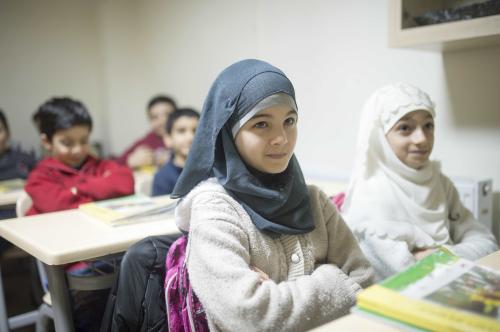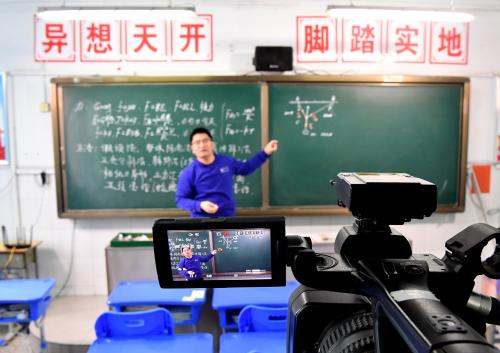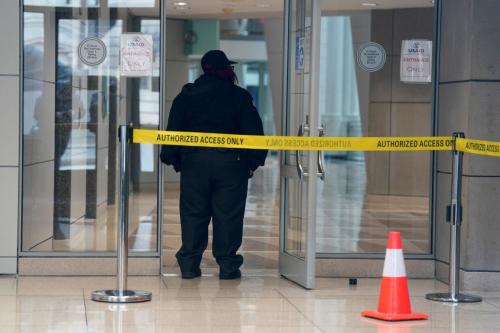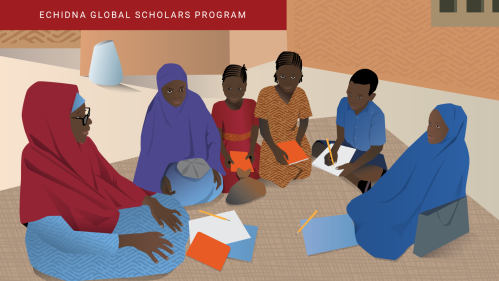In a simulation presented by Doctors Without Borders, participants had to choose the few items they would take with them if forced to flee. They faced a wall of plastic cards with pictures on them: shoes, medicine, passport, food, water. Even young children rushed to grab the card with the phone printed on it. Without phones of their own, they too knew instinctively the power of this connection (see also BBC’s “Where R U” video). Mobile phones are increasingly defining the way information about conflict is shared, humanitarian assistance is delivered, and how relationships through flight and exile are experienced.
Building on what exists in refugee communities
One teacher trainer in Dadaab refugee camps in Kenya told us that when working in the computer lab, his students would “unplug the monitor so that they could plug in their phones.” The ubiquity of access to personal technology among contemporary refugees is an opportunity for innovation in refugee education. Phones can provide access to resources, information, languages, curriculum, and more.
Tech companies have flooded this space with possibility—new apps, online learning portals, libraries. But, often lost in this rush to help, the best ideas may start very simply and originate within refugee communities. Being vigilant listeners and learners about existing educational work in refugee communities is one of the themes we put forward to help the tech community engage in refugee education. This theme has prompted us, over the past four years, to research ways that teachers of refugees are using their mobile phones as teaching tools.
In advance of this week’s Action for Teachers of Refugees and next week’s UNESCO Mobile Learning Week, we share how teachers of refugees use mobile phones to support their work and growth as educators.

Teaching and learning in Kakuma refugee camp, Kenya
The Kakuma refugee camp in Northwest Kenya opened in 1992, when displaced Sudanese fled into Kenya during Sudan’s second civil war. Today, approximately 200,000 refugees from 20 countries (double its capacity) live in Kakuma, a number that grew rapidly when conflict reignited in South Sudan in 2013. There are 21 primary schools and five secondary schools in Kakuma. It is a challenging place to teach: there are 150-300 students in each class, 10 students must share a single book, students come from many linguistic backgrounds, and many students are over aged due to years of missed schooling. Teachers in both primary and secondary schools are often refugees who have graduated from camp secondary schools and have not had access to further education or training. A number of teacher training programs have been initiated to help refugee and other teachers become better educators.
Mobile phones are supporting refugee teachers
Through long-term research in Dadaab, we found that students use Facebook groups to get feedback on their school essays as well as to interact with peers who can help them face challenges, like being the first girl in their family to go to school. Teachers, too, are using phones as teaching tools. One refugee teacher in Kakuma told us, “I actually use my phone when I am making class presentations… When it happens that a student asks me a very difficult question that I cannot answer, I will even pretend that I am [going] out for a short call or am going to handle any problem in the office, then I can use my phone to google [the answer].”
We asked teachers of refugees in Kenya who they communicate with using their mobile phones. Many have formed instant messaging groups with their peers to discuss teaching challenges and topics covered in their professional development programs. These groups are not initiated by programs, but by the teachers themselves, usually using Facebook Messenger or WhatsApp. As one teacher explained, “Around my area, I have a group of friends and also some of my colleagues who are working under [a teacher training] program too, and we have developed a WhatsApp group where we discuss issues concerning teaching. Like if we have a problem in school, we can discuss it and find a solution before we take it forward to our line supervisor or the community mobilizer.”
One teacher trainer, while recognizing the use of mobile phones, noted, “I think there is an overestimation of the role technology has played because it is mostly onsite relationships that makes things work.” Teachers of refugees agree about the value of in-person interactions. Yet, as we also find in research in Dadaab, face-to-face relationships can develop into productive virtual networks. While we often think about either virtual or face-to-face education programs in refugee settings, teachers of refugees show that the strategies are mutually supportive.
In addition to support for classroom-based instruction, teachers described how these chat groups played a role in shifting social norms in refugee camps. One teacher discussed how his cohort of teachers was working to educate men in the community about the importance of sending girls to school, including getting fathers, husbands, and brothers to participate in discussions about the issues and to join weekend training sessions. One teacher explained how virtual discussions and face-to-face discussions went hand-in-hand, stating, “[The men] form a …WhatsApp [group] where [the] guys can have the discussion there….” Through these self-initiated groups, teachers of refugees and community members extend their learning beyond the walls of a classroom and deepen their skills beyond the lessons of a particular training program. The leader of a training program in Kakuma agrees: “The goodness about the [WhatsApp] groups is that they are flexible and the teachers can get information [quickly]…, so it’s not restricted like in a classroom kind of setting…. [Also, these groups] are not expensive and we are also leveraging on existing technology.”

Investing in technology for refugee education
Teachers of refugees demonstrate the fine and crucial balance between actively harnessing innovative technology to support refugee education and leveraging what is already in use in refugee communities. In particular, our research finds that relationships are at the core of how teachers of refugees use technology for support both in and out of the classrooms. Teachers for Teachers is an exciting new model that reflects this idea. Peer supported learning and a mobile mentoring component of the program assist teachers in Kakuma to strengthen their relationships among teacher cohorts locally and to expand their relationships globally; these networks offer an exchange of experiences to develop new pedagogies and approaches to curriculum in multicultural and transnational refugee settings. We hope that these types of inexpensive and sustainable uses of existing technology help to shape the global conversation about mobile learning in refugee education.
The Brookings Institution is committed to quality, independence, and impact.
We are supported by a diverse array of funders. In line with our values and policies, each Brookings publication represents the sole views of its author(s).








Commentary
How teachers use mobile phones as education tools in refugee camps
March 14, 2017